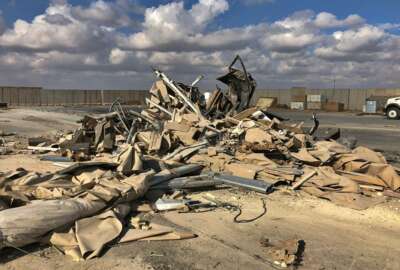With the number of U.S. troops who suffered traumatic brain injuries in the Jan. 8, Iranian attack on Ayn Al-Asad Airbase now up to 110, many are wondering how the Defense Department is classifying and treating those wounds.
Twenty-five of the service members who received TBIs were sent back to the United States for longer-term treatment. Most others returned to their jobs.
“Nobody has had a requirement for sustained inpatient care; nobody was diagnosed with a severe injury. But in some cases, they need follow-up that simply can’t easily be provided at a place like Al-Asad,” Joint Staff Surgeon General Brig. Gen. Paul Friedrichs told reporters Monday at the Pentagon. “We felt it was better for them to go back to their home unit, where they’ve got their support system, their family or unit support system around them, and get that outpatient care at their home unit.”
The military’s policy is that if anyone is within 50 meters of a blast area, has a direct blow to the head or has been exposed to more than one blast event then they must be evaluated for head trauma.
DoD also encouraged people who were experiencing TBI symptoms to come forward for testing in the weeks that followed the attack.
Friedrichs said that is why the number of TBIs changed over time, since around 11 were first reported after the attack.
“There’s some symptoms that are more common in folks with traumatic brain injury,” Friedrichs said. “Those include headache, dizziness, memory problems, balance problems, nausea, vomiting, difficulty concentrating, irritability, visual disturbance and ringing in the ears.”
The military uses the Military Acute Concussion Evaluation (MACE) to check people for TBIs.
“It includes a series of tests,” Friedrichs said. “Things like memory tests where, at the beginning, you’ll say, ‘I want you to remember these five terms.’ Later in the interview, you’ll ask them, ‘What were those five terms I asked you to remember?’ It’s a quick, very well validated, evidence-based test of cognition and how well the brain is functioning at the time of the interview.”
Those diagnosed with a TBI are told to rest for 24 hours and are evaluated again.
If the military couldn’t get a clear diagnosis it sent the troops to Germany for an MRI, where doctors were trained to look for TBIs.
Friedrichs said a majority of cases resolve in 30 days. Those whose injuries were longer were sent back to the United States.
“It can be a spectrum of injury,” Friedrichs said. “The most obvious one is if it actually causes an immediate bruise to the brain itself, and sometimes that can cause bleeding within the skull, or an injury that usually is going to be readily apparent. Other times, it can cause injury at the microscopic level, not as readily apparent, where individual nerves are damaged or torn, sometimes called shearing. If you can picture a nerve that gets pulled by the blast effect, that’s something that is harder to see on imaging studies, but still, a very real damage within the individual nerves that are damaged there.”
Lawmakers were concerned about the handling of TBIs after the attacks.
Rep. Bill Pascrell (D-N.J.), co-chairman and founder of the Congressional Brain Injury Task Force, sent a letter Thursday to the Defense Department expressing concern about possible blast injuries and concussions.
The letter asks DoD why troops were not required to report to bunkers for injury prevention and overall personnel safety. He also wants assurance that DoD remains committed to a $50 million research initiative between the Pentagon and the Department of Veterans Affairs that was announced last fall.
“Effects of traumatic brain injury can be short-term or long-term, and include impaired thinking or memory, movement, vision of hearing, or emotional functioning, such as personality changes or depression,” the Pascrell wrote in the letter. “Currently, between 3.2 million and 5.3 million people, including civilians, veterans and service members live with a TBI-related disability in the United States.”
Copyright
© 2024 Federal News Network. All rights reserved. This website is not intended for users located within the European Economic Area.

